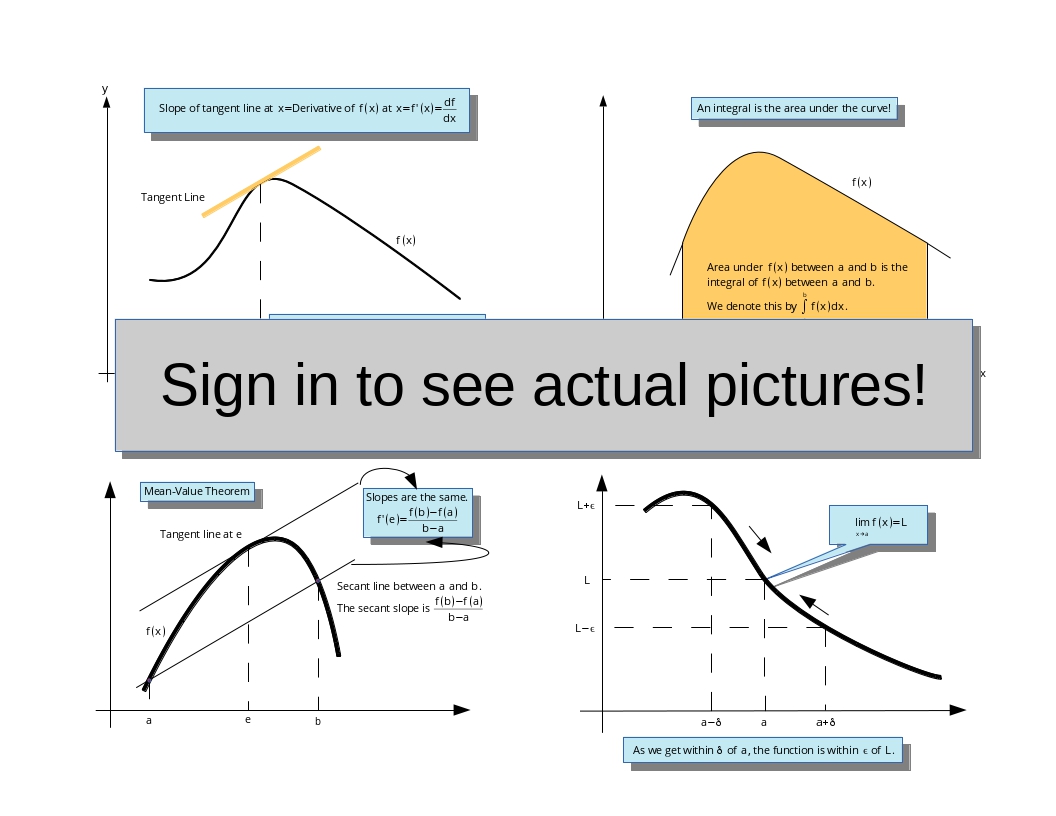Functions
Primary tabs
SAMPLE LESSON
Sign in for easy to read lessons narrowly focused on a specific subject. All lessons are linked to each other allowing you to easily see the connections between different Calculus concepts. Our unique Calcmap will give you a bird's-eye view of all our lessons and help you see how important concepts are related to each other. All of the formulas are available to our subscribers, but here is a sample of the lesson you will see when you log in:
A function is a way of assigning one set of numbers to another set of numbers. For example, let's say that I am at my home and I want to walk through downtown and across my city. As I do this I keep track of how far I am from home and I also measure the height of the buildings as I go. (Let's say I measure the height of the buildings on my right-hand side.) So at every distance from home there is a height of a building. This is a function. My function may look something like the following:

In general we label the horizontal axis the "x-axis", the vertical axis the "y-axis", and the function as "f(x)". So a typical function would look something like:

In the real world we would describe a function as we did above with the height of the buildings. However, in Calculus we speak about functions in a way that allows us to do more advanced mathematics on them. A more rigorous definition of a function will include four main elements of the function:
- A rule relating the x-axis with the y-axis. Typically this is an algebraic, trigonometric or other relationship such as x2, <Sign in to see all the formulas>, <Sign in to see all the formulas>, or <Sign in to see all the formulas>. For example, we would denote the function x2 as y=x2 or as <Sign in to see all the formulas>.
- For every value of x there is only one value of y. (We can't have two buildings on the same spot!) So while y=x2 is a function, <Sign in to see all the formulas> is not a function. Let's say that x=4 then for y=x2, y=16, but for <Sign in to see all the formulas>, y can take on the value of both +2 and −2. Now if we said <Sign in to see all the formulas> or <Sign in to see all the formulas> then these would be functions and we could denote them by <Sign in to see all the formulas> or <Sign in to see all the formulas>. (For <Sign in to see all the formulas> this fact is so well known that we usually see <Sign in to see all the formulas> which should always be taken to mean <Sign in to see all the formulas> and <Sign in to see all the formulas> to mean <Sign in to see all the formulas>.)
- The domain of the function is the portion of the x-axis for which the function is defined. (By defined we mean that f(x) is a number that we know.) Whenever the domain is not explicitly specified we assume that the domain is all real numbers for which f(x) is a real number. So for <Sign in to see all the formulas> then the domain is all real numbers. However, for <Sign in to see all the formulas> the domain is all positive numbers because the square root of a negative number is not a real number. When we do need to explicitly define the domain of a function we will do it with a bracket that explicitly dictates what rule relating the x and y axes is used for which domain. For example,
<Sign in to see all the formulas>
denotes a function whose domain is not made up of all real numbers. The domain is <Sign in to see all the formulas> which is a union of open and closed intervals. - The range of the function is the portion of the y-axis for which the function is defined. The range is determined from knowing the domain and the function f(x).
Here are some examples where we determine the domain, range, and graph of a function:
| Function | Domain | Range | Graph |
|---|---|---|---|
<Sign in to see all the formulas> | All real numbers: <Sign in to see all the formulas> | All positive real numbers: <Sign in to see all the formulas> |
 Enlarge |
<Sign in to see all the formulas> | All real numbers: <Sign in to see all the formulas> | All real numbers: <Sign in to see all the formulas> |
 Enlarge |
<Sign in to see all the formulas> | All positive real numbers: <Sign in to see all the formulas> | All negative real numbers: <Sign in to see all the formulas> |  Enlarge |
<Sign in to see all the formulas> | All real numbers: <Sign in to see all the formulas> | All real numbers between -1 and 1: <Sign in to see all the formulas> |
 Enlarge |
<Sign in to see all the formulas> | <Sign in to see all the formulas> | <Sign in to see all the formulas> |
 Enlarge |
Now try graphing some of your own functions on our Function Wizard!
